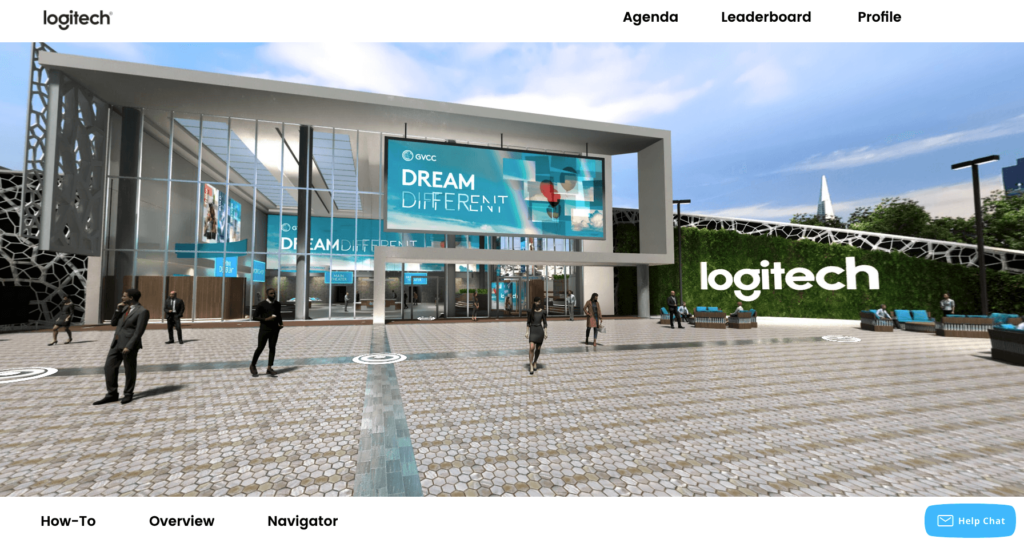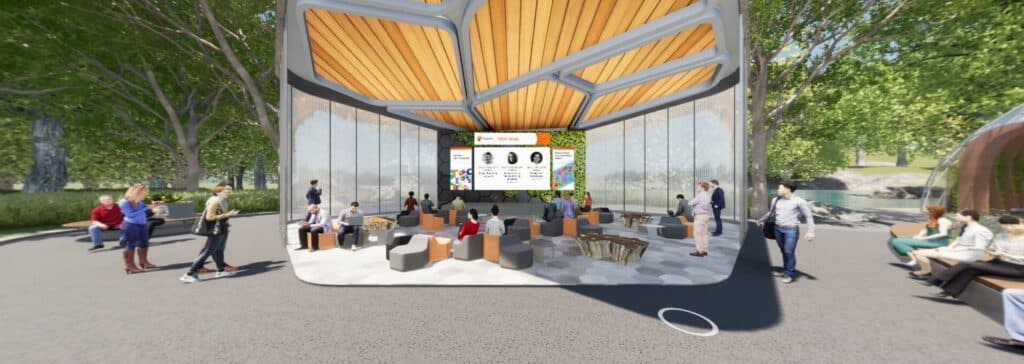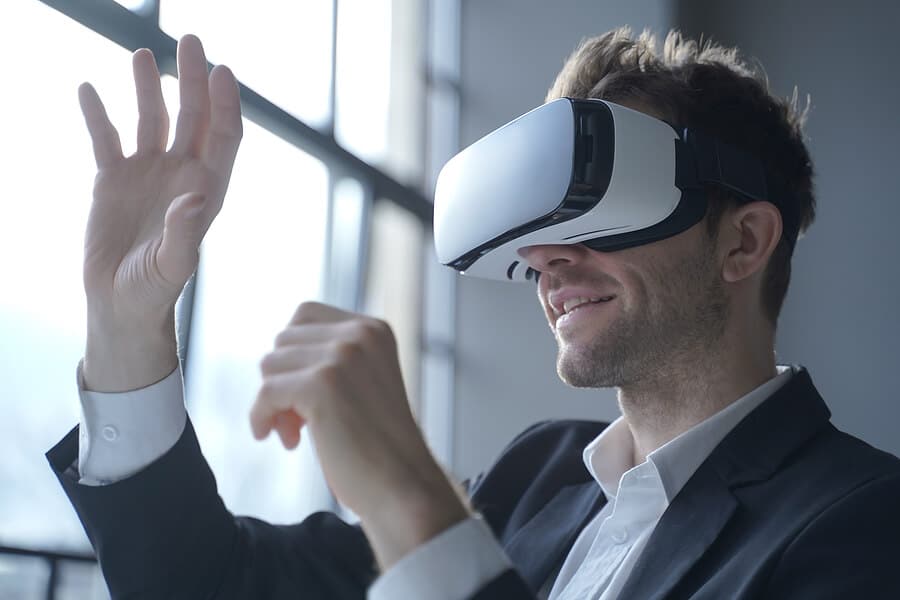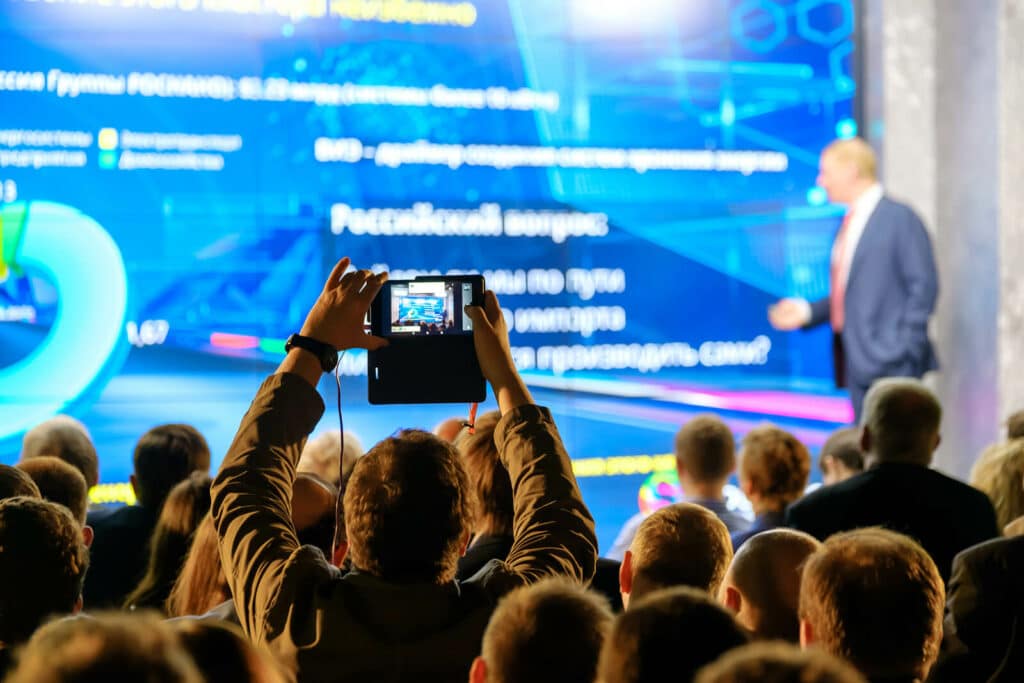Immersive technologies like virtual reality are being hyped as emerging technologies of the future. But immersive tech can be useful in the events industry right now, so why wait? If, like many event planners, you’re wondering:
- What is immersive technology?
- Does immersive tech have a place in the events I’m planning right now?
Read on; this should help you decide how best to use immersive technology in upcoming events.
What Is Immersive Technology?
An immersive technology either extends the parameters of our reality or creates an entirely new reality. Another defining aspect of immersive technologies is the use of 360° space. This means the user can look in any direction around them, including overhead, and see a version of reality that’s been created or altered using that technology.
All immersive technologies have these things in common. Where they differ is in how the user perceives the new reality and the extent to which they can interact with it.
Examples of Immersive Technology
Immersive technology is often thought of as being highly futuristic. But the truth is, there are types of immersion technology already being used and enjoyed by many people. True VR of the kind seen in sci-fi movies like The Matrix may still be a long way off, but there are elements of immersive technology that are already somewhat commonplace.
360° video technology is the simplest kind of immersive tech and the one most people are likely to have encountered. There are many examples of 360° videos online, on sites such as YouTube and Facebook. With these videos, the viewer takes the perspective of the camera that was used to record it.
360° videos are relatively simple to make. Many phone models have the ability to create these kinds of videos, using a Google app called Photo Sphere. It’s available on both iOS and Android phones and lets the user quickly create 360° videos just using their phone.
360° VR is 360° video taken a step further, in that it’s viewed with a VR headset that puts the user into the center of a 360° video. They can look in any direction, including overhead, and see the environment of the video. It’s not true VR, as it’s not stereoscopic, meaning there’s no depth to what the viewer’s looking at. It’s 360° but is still a flat 2D image from the perspective of the camera that recorded the video. This means the viewer can’t move “deeper” into the image unless the camera that recorded it does.
Virtual reality (VR) is a powerfully immersive technology that creates an entirely new world for the user to look at and explore. With this tech, the user wears a headset, and sometimes other equipment, that builds a virtual world with them at the center. VR is a 360° experience that is also stereoscopic. It has depth, which means the user can move around the virtual space.
Examples of VR tech include the Meta Quest 2 (formerly Oculus), Vive, and Playstation VR. Each of these uses a headset and various accessories that add extra sensory input.
Most current VR experiences are tethered, meaning the user wears devices that are connected to a console or computer via cables. However, the latest iteration of Oculus, Meta Quest 2, is wireless, meaning it’s one step further on the road to a true virtual reality experience.
Augmented reality (AR) adds virtual layers to the real world. When someone uses true VR tech, they’re essentially cut off from the real world. This isn’t the case with augmented reality, as this tech functions more like an extension of reality rather than a replacement.
One of the simplest and most widely adopted uses of AR are Snapchat and Instagram filters, which overlay digital images on top of real ones. Another example is the game Pokémon Go, which overlays digital characters on top of real-world locations.
Mixed reality (MR) is a combination of virtual and augmented reality and shares aspects of both. MR uses a headset, like VR does, but, functionally, it’s more like AR, as it overlays digital images over the top of the real world. Microsoft HoloLens is an example of immersive technology that uses MR.
Immersive Technology at Events: Applications and Benefits
To date, most VR investment has centered on the gaming industry. But other industries such as healthcare, manufacturing, and worker training make use of immersive technologies too. And in the events industry, certain kinds of augmented reality technology are starting to make a splash. Immersive technology can be used in a wide range of ways, from experiential marketing to education and training.
Branded Immersive Experiences
Branded immersive experiences are a kind of experiential marketing, where the experience is accessed via some kind of immersion technology. They’ve become a staple of trade shows, fairs, sporting events, and other big community events.
Benefits: Publicity, and lots of it. The novelty of using VR headsets and other such equipment is a big draw, and people tend to flock to these experiences in large numbers. Even if it means a large proportion of those visitors aren’t potential customers, the publicity and visibility are still major benefits.

VR Meetings and VR Conferencing
Virtual reality offers a new way to hold meetings in a fully digital environment. In many workplaces, remote working is now a permanent option, with employees working from home at least some of the time. Online business meetings via Zoom and other videoconferencing platforms have become the norm.
For some companies, immersive technologies are the way forward, thanks to the improved level of interactivity they offer. With traditional videoconferencing platforms like Zoom, meeting participants use their webcams to watch the proceedings. In virtual reality meetings, participants wear VR headsets that allow them to attend “in person” and sit in a meeting room with other attendees. Rather than staring at a computer screen, attendees can look around the virtual space just as though they were in a real meeting room.
Benefits: VR is a more immersive and engaging way to attend a meeting, especially in comparison to a Zoom conference. Because of that, it means better attendance figures and higher levels of participation.
Many VR conferencing apps also have features that facilitate interaction, such as writing notes they can share with the group, screencasting, image sharing, and more. This means attendees can easily collaborate and share information as they would at in-person business meetings, even if every participant is in a different physical environment.
Training and Education Sessions
Training and education is currently one of the most common applications for immersive technologies. In particular, the healthcare industry has been quick to adopt immersive learning technology. For instance, a company called FundamentalVR has developed a kind of VR training that uses “haptic feedback”, which engages the user’s sense of touch. This means that when trainee surgeons use the technology in a surgical simulation, it actually feels as though they’re using surgical tools to operate on flesh—something that is often lacking with simulations. The tech does have limitations, but VR remains an important and well-established training tool for new surgeons.
Benefits: Using VR technology provides a safer means of training and onboarding new workers. It’s ideal for situations where putting inexperienced staff on the job can pose a safety hazard or would slow a manufacturing process down. Plus, it’s a much more engaging way of training, meaning better retention and understanding of the material being learned.

3D Studio Technology
This mixed reality tech is a way of creating digital environments that incorporate real people. It’s a specialty for XtendLive, who use this AR tech to insert real-time recorded or livestreamed video into a 3D virtual world. This completely alters what the visuals look like, as it effectively puts real people into the virtual environment. People can be filmed anywhere, in any location, and it’s even possible to put multiple people—from different video sources—into the same 3D virtual world.
Benefits: This style of production is incredible for virtual and hybrid events, making it possible to create presentations that are more dynamic, visually interesting, and engaging, with higher production values that approach those of broadcast TV. Using 3D studio technology, it’s possible to create these highly detailed and engaging 3D environments that are built around real presenters and speakers. And these presentations can then be slotted right into a virtual event environment, for a new and exciting take on a keynote, education session, or panel discussion.
Immersive Technology Means Richer and More Engaging Virtual Event Experiences
Immersive technology is still in its infancy in terms of what the tech can do right now. But even so, it can accomplish plenty already. With extended reality technology, you can create virtual event experiences that are more interactive, interesting, and engaging. For any kind of event, whether it’s an in-house business meeting, a training session, or an experiential trade show booth, that puts you on a better path to reach your event goals.









